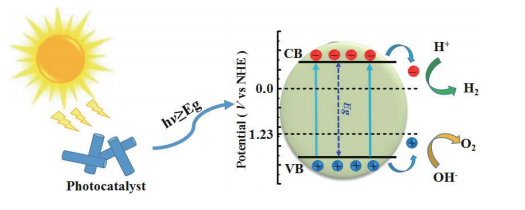The utilization of solar energy to drive energy conversion and simultaneously realize pollutant degradation via photocatalysis is one of most promising strategies to resolve the global energy and environment issues. During the past decade, graphite carbon nitride (g-C3N4 ) has attracted dramatically growing attention for solar energy conversion due to its excellent physicochemical properties as a photocatalyst. However, its practical application is still impeded by several limitations and shortcomings, such as high recombination rate of charge carriers, low visible-light absorption, etc. As an effective solution, the electronic structure tuning of g-C3N4 has been widely adopted. In this context, firstly, the paper critically focuses on the different strategies of electronic structure tuning of g-C3N4 like vacancy modification, doping, crystallinity modulation and synthesis of a new molecular structure. And the recent progress is reviewed. Finally, the challenges and future trends are summarized.
With the rapid development of the world economy and the increase of the population, the energy crisis and environmental pollution have gradually become the key challenges for the sustainable development of mankind. As a powerful and sustainable strategy, photocatalysis has been regarded as one of the most promising energy conversion processes to utilize green and inexhaustible solar energy for exploiting ideal fuels and simultaneously promoting environmental remediation. As a critical part of the photocatalytic process, plenty of semiconductor photocatalysts, such as TiO2 , ZnO, Ag3PO4 , SrTiO3 , BiVO4 and CdS, etc., have been synthesized for different photocatalytic reactions during the past few decades. However, most metal–oxide semiconductors can only respond to a small part of the solar spectrum due to their wide band gaps. Although metal sulfides, metal phosphides, and metal nitrides photocatalysts possess a narrow bandgap, the deleterious and volatile properties due to the photocorrosion and self-oxidation, severely limit their wide application in the field of photocatalysis. Moreover, most photocatalysts are inorganic semiconductors whose optical and electronic properties can only be regulated in a small range. Thus far, the development of highly efficient semiconductor photocatalysts has received extensive attention and gradually become a research hotspot.
Up to now, although many interesting reviews on the strategies to improve the photocatalytic property of g-C3N4 have been reported, a crucial review focusing on the electronic structure tuning of g-C3N4 is lacking to provide the researchers with a panorama of the latest advances in this field. Herein, we present a comprehensive and updated review on the most recent progress in the electronic structure tuning of g-C3N4 for highly efficient photocatalysis. The diverse design and regulation strategies for optimizing the electronic structure of g-C3N4 are elaborated on and the effect of the electronic structure tuning on the properties and photocatalytic activities of g-C3N4 are also summarized. Moreover, this review will present some novel insights on the crucial challenges, opportunities, and inspiring perspectives for the design of highly efficient g-C3N4 -based photocatalysts, which should be a guide for future research in this hot area.

Fig1
Recent studies found that defect engineering by the introduction of carbon and/or nitrogen vacancy defects into the motif of g-C3N4 has a pronounced effect on its electronic structure and photocatalytic performance, which is mainly due to that the VB and CB of g-C3N4 are composed of nitrogen PZ orbitals and carbon PZ orbitals, respectively . The calculation based on DFT had found that a mid-gap energy level has appeared above the VB when the N vacancy was introduced into the framework of g-C3N4 . Moreover, the C or N defects can serve as trapping and active sites to improve the separation of photo-generated carriers, and enhance the adsorption ability of g-C3N4 to the reactant. For example, Li and coworkers recently designed a N-vacancy-rich g-C3N4 , and found that N vacancies acted as active sites, which could obviously promote the adsorption of CO2 during the CO2 reduction. Therefore, the appropriate introduction of vacancies into the framework of g-C3N4 can regulate its band structure effectively, and improve the light-responding range and photocatalytic performance, simultaneously.
Generally, the C or N defects can be successfully introduced into the framework when the bulk g-C3N4 is thermally treated under H2 , Ar, NH3 or N2 atmosphere. For example, Zhou and coworkers presented a novel route to prepare N- vacancy-rich g-C3N4 by heating the bulk g-C3N4 to different temperatures under N2 conditions. This rich N vacancy in g-C3N4 produce an obvious electron-deficient effect, which not only contribute to stabilizing the Pt single atom, but also endow the Pt single atom with an optimized geometric and electronic structures for capturing electrons and producing hydrogen . However, the post treatment strategy by gas etching is time-consuming and difficult to control the defects. Moreover, the inappropriate defect location and defect concentration may not only destroy the lattice structure of g-C3N4 but also impede the separation and transportation of photo-generated carriers, which finally deteriorate the photocatalytic performance of g-C3N4 . Therefore, it is very necessary to develop new, facile and controllable strategies for the synthesis of g-C3N4 with appropriate defects and significantly improved photocatalytic activity.
上一篇: 扭角二维超晶格及其在(光)电子学中的应用
下一篇: 硅光子学上的雪崩光电二极管